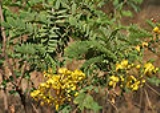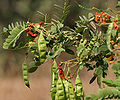
Senna auriculata
Encyclopedia
Senna auriculata is a legume tree
in the subfamily Caesalpinioideae
. It is commonly known by its local names ranawara or avaram, (Telugu: తంగేడు , taMgEDu] or the English version Avaram Senna.
It occurs in the dry regions of India
and Sri Lanka
. It is common along the sea coast and the dry zone in Sri Lanka.
 Avaram Senna is a much branched shrub with smooth cinnamon brown bark and closely pubescent brachlets.
Avaram Senna is a much branched shrub with smooth cinnamon brown bark and closely pubescent brachlets.
The leaves are alternate, stipulate, paripinnate compound, very numerous, closely placed, rachis 8.8-12.5 cm long, narrowly furrowed, slender, pubescent, with an erect linear gland between the leaflets of each pair, leaflets 16-24, very shortly stalked 2-2.5 cm long 1-1.3 cm broad, slightly overlapping, oval oblong, obtuse, at both ends, mucronate, glabrous or minutely downy, dull green, paler beneath, stipule
s very large, reniform-rotund, produced at base on side of next petiole into a filliform point and persistent.
Its flowers are irregular, bisexual, bright yellow and large (nearly 5 cm across), the pedicel
s glabrous and 2.5 cm long. The raceme
s are few-flowered, short, erect, crowded in axils of upper leaves so as to form a large terminal inflorescence
(leaves except stipules are suppressed at the upper nodes). The 5 sepal
s are distinct, imbricate, glabrous, concave, membranous and unequal, with the two outer ones much larger than the inner ones. The petal
s also number 5, are free, imbricate, crisped along the margin, bright yellow veined with orange. The anthers number 10 and are separate, with the three upper stamen
s barren; the ovary is superior, unilocular, with marginal ovules.
The fruit is a short legume, 7.5–11 cm long, 1.5 cm broad, oblong, obtuse, tipped with long style base, flat, thin, papery, undulately crimpled, pilose, pale brown. 12-20 seeds per fruit are carried each in its separate cavity.
(sennapicrin) and sap, leaves and bark yield anthraquinone
anthraquinones, while the latter contains tannin
s.
The root is used in decoction
s against fevers
, diabetes, diseases of urinary system
and constipation
. The leaves have laxative
properties. The dried flowers and flower buds are used as a substitute for tea in case of diabetes patients. It is also believed to improve the complexion in women. The powdered seed is also applied to the eye, in case of chronic purulent conjunctivitis
. In Africa the bark and seeds are said to give relief in rheumatism
, eye diseases, gonorrhea
, diabetes and gout
.
The plant has been shown to have antibacterial activity in the laboratory.
Tree
A tree is a perennial woody plant. It is most often defined as a woody plant that has many secondary branches supported clear of the ground on a single main stem or trunk with clear apical dominance. A minimum height specification at maturity is cited by some authors, varying from 3 m to...
in the subfamily Caesalpinioideae
Caesalpinioideae
Caesalpinioideae is a botanical name at the rank of subfamily, placed in the large family Fabaceae or Leguminosae. Its name is formed from the generic name Caesalpinia....
. It is commonly known by its local names ranawara or avaram, (Telugu: తంగేడు , taMgEDu] or the English version Avaram Senna.
It occurs in the dry regions of India
India
India , officially the Republic of India , is a country in South Asia. It is the seventh-largest country by geographical area, the second-most populous country with over 1.2 billion people, and the most populous democracy in the world...
and Sri Lanka
Sri Lanka
Sri Lanka, officially the Democratic Socialist Republic of Sri Lanka is a country off the southern coast of the Indian subcontinent. Known until 1972 as Ceylon , Sri Lanka is an island surrounded by the Indian Ocean, the Gulf of Mannar and the Palk Strait, and lies in the vicinity of India and the...
. It is common along the sea coast and the dry zone in Sri Lanka.

The leaves are alternate, stipulate, paripinnate compound, very numerous, closely placed, rachis 8.8-12.5 cm long, narrowly furrowed, slender, pubescent, with an erect linear gland between the leaflets of each pair, leaflets 16-24, very shortly stalked 2-2.5 cm long 1-1.3 cm broad, slightly overlapping, oval oblong, obtuse, at both ends, mucronate, glabrous or minutely downy, dull green, paler beneath, stipule
Stipule
In botany, stipule is a term coined by Linnaeus which refers to outgrowths borne on either side of the base of a leafstalk...
s very large, reniform-rotund, produced at base on side of next petiole into a filliform point and persistent.
Its flowers are irregular, bisexual, bright yellow and large (nearly 5 cm across), the pedicel
Pedicel (botany)
A pedicel is a stem that attaches single flowers to the main stem of the inflorescence. It is the branches or stalks that hold each flower in an inflorescence that contains more than one flower....
s glabrous and 2.5 cm long. The raceme
Raceme
A raceme is a type of inflorescence that is unbranched and indeterminate and bears pedicellate flowers — flowers having short floral stalks called pedicels — along the axis. In botany, axis means a shoot, in this case one bearing the flowers. In a raceme, the oldest flowers are borne...
s are few-flowered, short, erect, crowded in axils of upper leaves so as to form a large terminal inflorescence
Inflorescence
An inflorescence is a group or cluster of flowers arranged on a stem that is composed of a main branch or a complicated arrangement of branches. Strictly, it is the part of the shoot of seed plants where flowers are formed and which is accordingly modified...
(leaves except stipules are suppressed at the upper nodes). The 5 sepal
Sepal
A sepal is a part of the flower of angiosperms . Collectively the sepals form the calyx, which is the outermost whorl of parts that form a flower. Usually green, sepals have the typical function of protecting the petals when the flower is in bud...
s are distinct, imbricate, glabrous, concave, membranous and unequal, with the two outer ones much larger than the inner ones. The petal
Petal
Petals are modified leaves that surround the reproductive parts of flowers. They often are brightly colored or unusually shaped to attract pollinators. Together, all of the petals of a flower are called a corolla. Petals are usually accompanied by another set of special leaves called sepals lying...
s also number 5, are free, imbricate, crisped along the margin, bright yellow veined with orange. The anthers number 10 and are separate, with the three upper stamen
Stamen
The stamen is the pollen producing reproductive organ of a flower...
s barren; the ovary is superior, unilocular, with marginal ovules.
The fruit is a short legume, 7.5–11 cm long, 1.5 cm broad, oblong, obtuse, tipped with long style base, flat, thin, papery, undulately crimpled, pilose, pale brown. 12-20 seeds per fruit are carried each in its separate cavity.
Gardens
Senna auriculata is suitable for landscaping roadways and home gardens. It tolerates drought and dry conditions, but not much cold. The flowers in racemes are also attractive.Medicinal uses
This plant is said to contain a cardiac glucosideGlucoside
A glucoside is a glycoside that is derived from glucose. Glucosides are common in plants, but rare in animals. Glucose is produced when a glucoside is hydrolysed by purely chemical means, or decomposed by fermentation or enzymes....
(sennapicrin) and sap, leaves and bark yield anthraquinone
Anthraquinone
Anthraquinone, also called anthracenedione or dioxoanthracene is an aromatic organic compound with formula . Several isomers are possible, each of which can be viewed as a quinone derivative...
anthraquinones, while the latter contains tannin
Tannin
A tannin is an astringent, bitter plant polyphenolic compound that binds to and precipitates proteins and various other organic compounds including amino acids and alkaloids.The term tannin refers to the use of...
s.
The root is used in decoction
Decoction
Decoction is a method of extraction, by boiling, of dissolved chemicals, or herbal or plant material, which may include stems, roots, bark and rhizomes. Decoction involves first mashing, and then boiling in water to extract oils, volatile organic compounds, and other chemical substances...
s against fevers
Fevers
Fevers are a five-piece band formed in 2010 in Ottawa, Ontario. The band consists of Colin MacDougall , Jim Hopkins , Martin Charbonneau , Sarah Bradley and Mike Stauffer . Theirs is a fresh take on a classic genre, combining indie rock and electronic music...
, diabetes, diseases of urinary system
Urinary system
The urinary system is the organ system that produces, stores, and eliminates urine. In humans it includes two kidneys, two ureters, the bladder and the urethra.-Kidney:...
and constipation
Constipation
Constipation refers to bowel movements that are infrequent or hard to pass. Constipation is a common cause of painful defecation...
. The leaves have laxative
Laxative
Laxatives are foods, compounds, or drugs taken to induce bowel movements or to loosen the stool, most often taken to treat constipation. Certain stimulant, lubricant, and saline laxatives are used to evacuate the colon for rectal and/or bowel examinations, and may be supplemented by enemas under...
properties. The dried flowers and flower buds are used as a substitute for tea in case of diabetes patients. It is also believed to improve the complexion in women. The powdered seed is also applied to the eye, in case of chronic purulent conjunctivitis
Conjunctivitis
Conjunctivitis refers to inflammation of the conjunctiva...
. In Africa the bark and seeds are said to give relief in rheumatism
Rheumatism
Rheumatism or rheumatic disorder is a non-specific term for medical problems affecting the joints and connective tissue. The study of, and therapeutic interventions in, such disorders is called rheumatology.-Terminology:...
, eye diseases, gonorrhea
Gonorrhea
Gonorrhea is a common sexually transmitted infection caused by the bacterium Neisseria gonorrhoeae. The usual symptoms in men are burning with urination and penile discharge. Women, on the other hand, are asymptomatic half the time or have vaginal discharge and pelvic pain...
, diabetes and gout
Gout
Gout is a medical condition usually characterized by recurrent attacks of acute inflammatory arthritis—a red, tender, hot, swollen joint. The metatarsal-phalangeal joint at the base of the big toe is the most commonly affected . However, it may also present as tophi, kidney stones, or urate...
.
The plant has been shown to have antibacterial activity in the laboratory.

